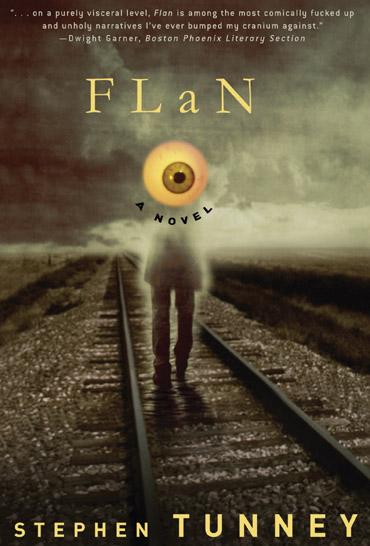
REVIEWS OF FLAN :
New York Press
Review of Contemporary Fiction
San Francisco Chronicle
Boston Phoenix Literary Section
Q Magazine (UK)
Your Flesh (Minneapolis)
VOX Magazine (UK)
Event (UK)
Option (USA)
|
|
FLAN
The Novel By
Stephen Tunney
New Edition Published in 2008 by
Running Press
Flan was originally published in 1992 by Four Walls Eight Windows.

The following is from
The Review of Contemporary Fiction (Fall 1993)
Murder, Rape, blasphemy, and suicide are only a few of the apocalyptic delights offered up on nearly every page of Flan Stephen Tunney's violent and grotesque first novel. It is a beautifully dangerous book. By so ferociously sodomizing the language, Tunney gives us something spontaneous and hugely funny--a novel in the rogue tradition of Don Quixote and Naked Lunch, full of delirious nonsense and delicious irony, a novel sure to delight a few and offend many.
Flan is set during an unnamed holocaust (probably nuclear war) that has turned the American landscape into a smoldering, cartoonlike wasteland--called Hell by Flan, the "hero" of this novel--where beasts sprout human heads and the few people still alive have been reduced to strangely enthusiastic cannibalism. As a literary character, Flan is a cross between Beaver Cleaver and Celine's Bardamu; a vicious misanthropy lurks beneath his gee-wiz naivete. After waking up to find his apartment building on fire, Flan rescues his talking fish, Ginger Kang Kang, and sets out to find his girlfriend somewhere in the mountains. It is indeed a journey through Hell--people are taking the food from the stomachs of corpses, animals have become as conniving and eloquent as humans, and teenage bandits roam the countryside raping and pillaging. They encounter strange and unbelievable things: a walking, talking human, for example, "made up of one thousand three hundred and seventy-seven small hummingbirds, six hundred thousand four hundred and ninety-two ants, twelve tapeworms, and one corpse. The corpse is dead, but the rest of us are quite alive and well, thank you, and we all work together in perfect unison." Flan is the kind of work that completely rejects the notion that the novel must be a carefully plotted, highly polished narrative. Tunney, a painter by profession, has an improvisatory, highly visual writing style that derives its energy from cartoons, comics, and commercials--a disposition that links him in spirit to writers like Donald Barthelme and Jerome Charyn. Readers who relish the bizarre extremes of contemporary writing should not miss Flan.
Review by James DeRossit
The following is from
OPTION MAGAZINE (Winter 1993)
Known in musical circles as Dogbowl, co-founder of King Missile and now a solo artist, Stephen Tunney also paints and writes. His first novel, similar in content to his songs and artwork, is the literary equivalent of the famous eyeball-slitting scene in the Bunuel film Un Chien Andalou. The post-apocalyptic horror story takes the same perverse, almost juvenile delight in imagery that disgusts and dazzles simultaneously; imagery that at times lends a surreal, poetic beauty to the unspeakable atrocities and grotesque creatures that litter the author's blasted New York City landscape.
Like the Surrealists and Dadaists, whose art was partly a response to the horrors of World War 1, Tunney sees civilization as thin veneer masking the darkest impulses of the human psyche; just one nuclear exchange, he suggests, and all the acts of savagery that populate his book--rape, murder, decapitation, cannibalism--could and will take place, and in fact are taking place now. There's no escape from the carnage, either for Tunney's hapless protagonist Flan, or for the reader. The novel is unrelenting in its depictions of mayhem as it follows Flan and his pet talking fish, Ginger Kang Kang, on a journey to find Flan's fiancee, Holly. A sample passage, chosen by simply opening to an arbitrary page, reads: "A man with a big jolly bump on his head tore a hole in his arm and pulled up a red vein. He drank blood from it like a straw, his lips puckered a candy cane blue." Tunney comes off as a cross between Karen Finley and James Joyce in the trancelike way his words tumble off the page with nauseating force. There's something exultant and even erotic (I wonder if he's Catholic?) about such passages; he makes Flan's copulating with his pet fish a genuinely sexy scene. For many, Tunney's blood lust will obscure his poetic gifts; some images will haunt you long after you finish the book: the lake of glass that once was New York City; the flakes of ash that fall silently, ceaselessly from the low, brown clouds; the cloud of hummingbirds that find a voice through their puppet like manipulation of a corpse. It's questionable how many readers will allow themselves to see the novel's strange beauty, since nausea and artistic appreciation are strange bedfellows; after all, Francis Bacon and David Cronenberg (to name just two) were not overnight successes. Were it just a brilliantly inventive atrocity exhibition, devoid of redemption, Flan would not be worth the effort. There's enough cruelty in the world without another gratuitous celebration of life's horrors. But on this key issue Tunney betrays a surprising streak of idealism without sacrificing the integrity of the story. As hero/Everyman, Flan is not an appealing character; in fact, he's a bumbling boob, obsessed with the toupee that covers the seat of his childlike intellect. Neither the author nor the reader holds much compassion for him at first, as he clumsily escapes one horrific menace after another in pursuit of Holly, who, if she ever existed, is now obviously a long-gone illusion. Yet that same love--the longing for a person or a peaceful place he may never reach--sets Flan (read: Man) apart from the bestial, mutated creatures he encounters on his Quixotic quest. Without love there's no hope; without hope there's no humanity. In Flan, the ultimate underdog looking for love in a world offering only Death, Tunney has found a heartbreaking, Beckett-ian symbol for the human condition.
Reviewed by Gordon Anderson
|